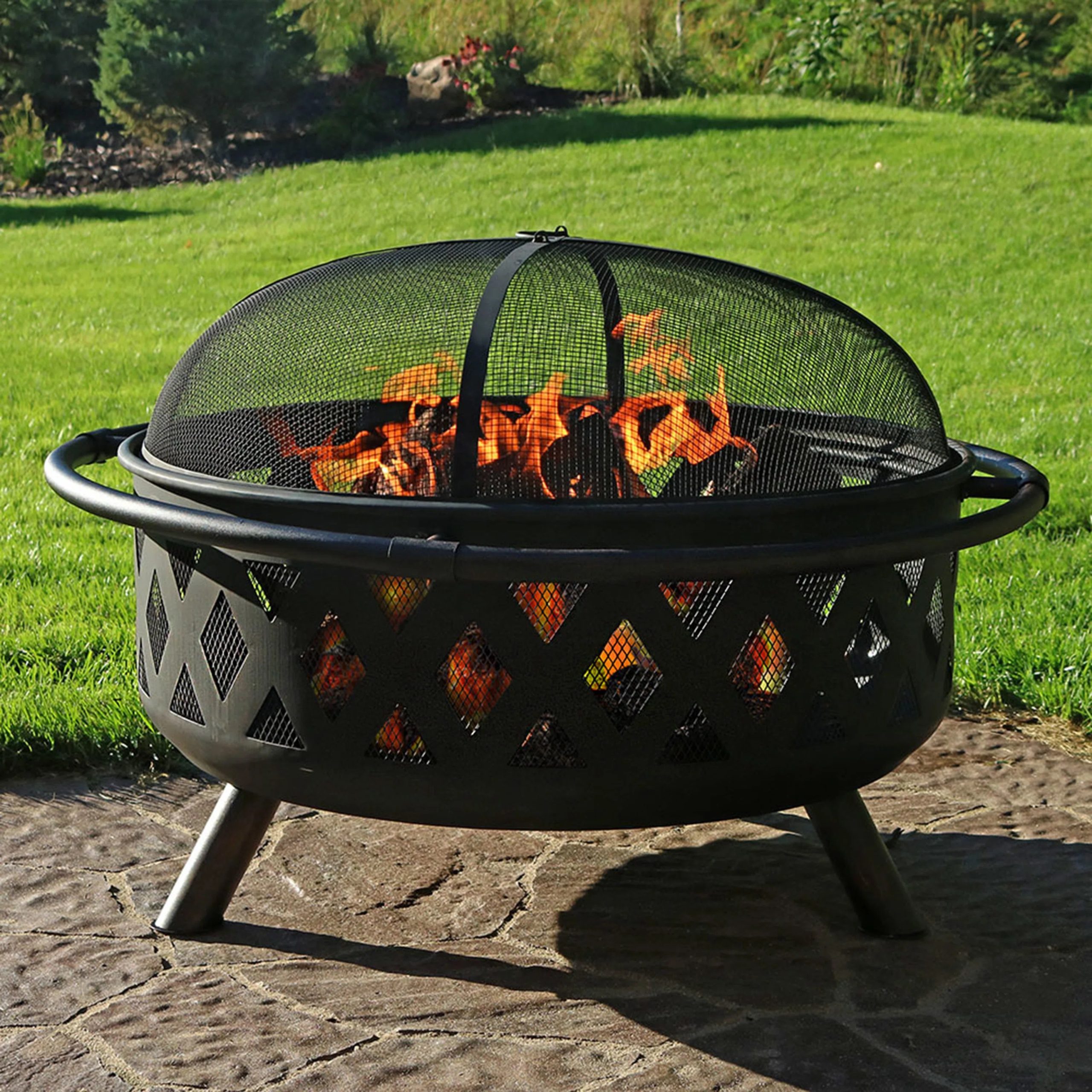Want to transform your backyard into the ultimate hangout spot? A big fire pit is likely just the ticket! Imagine cozy nights under the stars, the crackling flames drawing everyone together. This comprehensive guide covers everything fire pits, from choosing the right type and size to essential safety tips and maintenance. Whether you’re a fire pit novice or a seasoned pro, get ready to ignite your backyard dreams!
Choosing Your Fire Pit
Fueling the Fire: Wood, Propane, or Natural Gas?
Your first decision? What type of fuel best suits your needs. Traditional wood-burning fire pits offer that classic campfire ambiance, but can be smoky and require a readily available supply of seasoned firewood. For convenience, propane fire pits offer instant flames with the push of a button. Natural gas provides a clean, constant fuel source, although professional installation is usually necessary.
Sizing Up Your Space
Finding the right size is crucial. A smaller 36-inch fire pit might suit a cozy patio, while a 47-inch (or larger) model could be ideal for a spacious backyard. [https://www.wavesold.com/what-is-a-good-size-fire-pit-for-a-backyard] explores fire pit sizing in more detail. Consider how many people you typically entertain and the available space.
Material Matters: Durability and Style
From rustic steel to elegant copper, your fire pit’s material impacts both its longevity and aesthetic. Steel is popular for its strength and weather resistance, while copper develops a unique patina over time. Concrete offers a modern, sturdy option, and cast iron exudes classic charm. Each material has pros and cons regarding maintenance and how it complements your backyard design.
Enhancing Your Fire Pit Experience: Features and Accessories
Take your fire pit experience to the next level with features like grill grates for cooking, an outer ledge or table for drinks, and a custom-fit cover for protection.
| Feature | Benefit | Example Product Types |
|---|---|---|
| Grill Grate | Allows for cooking directly over the fire | Some OutVue and PapaBabe models often include these |
| Outer Ledge/Table | Provides a surface for drinks and other items | Look for fire pits with built-in ledges or consider separate tables |
| Cover | Protects the fire pit from weather damage | Many manufacturers offer custom-fit covers |
Safety First: Responsible Fire Pit Practices
While enjoyable, fire pit safety is paramount. Place your fire pit a safe distance from structures, trees, and overhanging branches. Ensure proper ventilation and always use a fire pit pad or mat. [https://www.wavesold.com/how-to-build-a-big-fire-pit] offers more in-depth safety advice.
Maintaining Your Fire Pit
Regular cleaning, including ash and debris removal, is vital for preventing rust and maintaining your fire pit’s appearance. Specific maintenance steps vary by material, so consult the manufacturer’s instructions.
Budgeting for Your Backyard Bliss
Big fire pits range from budget-friendly to high-end. [https://www.wavesold.com/is-it-cheaper-to-build-or-buy-a-fire-pit] helps you decide if building or buying is more cost-effective. Set a realistic budget based on desired size, material, and features.
Finding Your Dream Fire Pit
Retailers like Amazon, Woodland Direct, and Tractor Supply Co. offer diverse big fire pit selections. Solo Stove is a popular choice for smoke-free burning.
What Is a Good Size Fire Pit for a Backyard?
Choosing the right fire pit size is like finding the perfect chair – it needs to fit your space and how you intend to use it. For intimate gatherings (2-4 people), a 24-36 inch diameter fire pit often suffices. Medium gatherings (4-6 people) might benefit from a 36-44 inch diameter. Larger groups (6+ people) may necessitate a 48-60 inch (4-5 foot) diameter fire pit.
Beyond size, consider shape. Round fire pits are versatile for seating arrangements, while square or rectangular options offer a modern aesthetic and can be surprisingly fuel-efficient. Fuel type also influences size. Wood-burning pits require larger clearances (70-inch radius) compared to gas pits (65-inch radius).
Material impacts performance and style. Concrete offers durability, metal exudes a contemporary feel, and stone brings timeless elegance. Each material has varying heat retention and durability properties. Some experts suggest heavy gauge copper fire bowls age beautifully, adding unique character to your outdoor space.
Finally, prioritize seating and accessibility. Built-in benches offer a permanent solution, while Adirondack chairs create a casual vibe. Consider ramps and wider pathways for guests with mobility limitations.
How to Build a Big Fire Pit
Building a fire pit can be a rewarding DIY project. Before you begin, meticulous planning is essential. Choose a safe location, considering wind direction, proximity to structures, and property lines. Check local regulations and determine the desired size and shape, keeping in mind larger pits require more materials and labor.
Select appropriate materials for the exterior (stone, brick, concrete blocks, pavers) and the interior (firebricks). Gather gravel for drainage, sand for leveling, and rebar for reinforcing concrete. A metal fire ring enhances durability. Remember to contact utility companies before digging to avoid damaging underground lines.
Construction Steps:
- Mark and Prepare: Outline the shape and excavate to the appropriate depth.
- Gravel Base: Add a layer of gravel for drainage.
- Footing (Optional): Pour a concrete footing, reinforced with rebar, for larger pits.
- Firebrick Liner: Mortar firebricks in place, leaving small gaps for airflow.
- Outer Wall: Build the outer wall using your chosen material.
- Cure: Allow ample curing time for mortar and concrete.
Prioritize safety. Maintain safe clearances, keep a fire extinguisher nearby, never leave a fire unattended, and use appropriate fuel. Consider a spark screen. Building for longevity includes proper drainage, durable materials, and sealing.
Personalize your fire pit with built-in seating, a patio, or decorative elements. Ensure accessibility with ramps or wider openings. Eco-conscious builders might use recycled materials. Regular cleaning, ash removal, and occasional firebrick replacement maintain your fire pit’s condition.
Is It Cheaper to Build or Buy a Fire Pit?
The age-old question: build or buy? While DIY materials might seem cheaper initially, hidden costs (tools, time) can add up. Pre-built fire pits offer convenience and immediate enjoyment, but limit customization.
DIY offers complete control over design, but demands a greater investment. Pre-built options are generally more limited. Consider long-term costs: maintenance, fuel, and potential repairs.
DIY can be rewarding and potentially cost-effective for skilled builders with the necessary tools. If you value convenience and a predictable budget, a pre-built fire pit might be the better choice.
Here’s a cost comparison:
| Feature | DIY Fire Pit | Pre-built Fire Pit |
|---|---|---|
| Cost | $300 – $5,000+ (or more!) | $35 – $500+ |
| Time Investment | Significant (weeks or weekends) | Minimal (hours) |
| Customization | High | Limited |
| Convenience | Low | High |
| Maintenance | Variable | Variable, often simpler |
Ultimately, the best approach depends on your individual circumstances, priorities, and the value you place on your time and effort.
Discover the fascinating world of the big aloe plant and unlock its many secrets, from medicinal uses to home decor inspiration. Delve deeper into the specific benefits and care tips for a big aloe vera plant and transform your green thumb game.
- 30+ Beautiful Flowers That Start With N (Pictures and Growing Guides) - April 22, 2025
- 40+ Flowers That Start With L: A Comprehensive Guide - April 22, 2025
- 20+ Fabulous Flowers That Start With J: A Complete Guide - April 22, 2025










